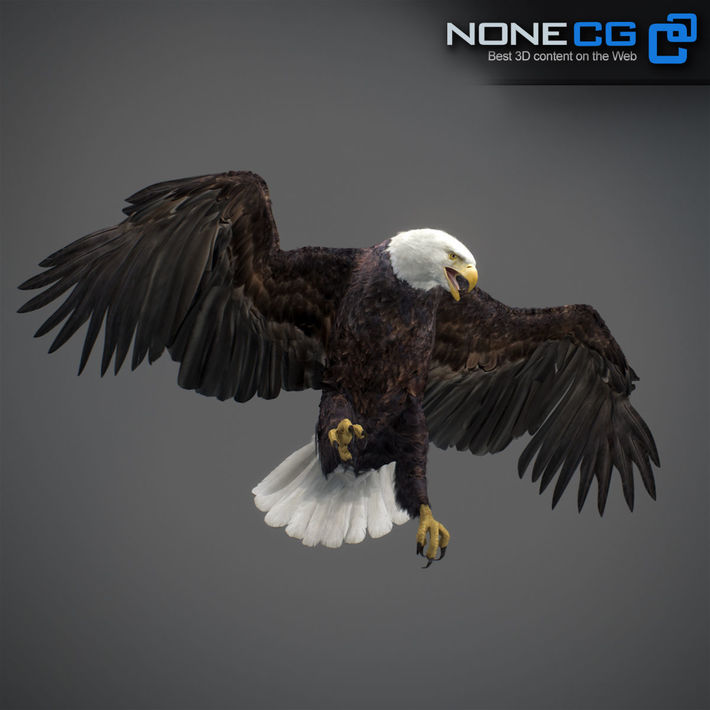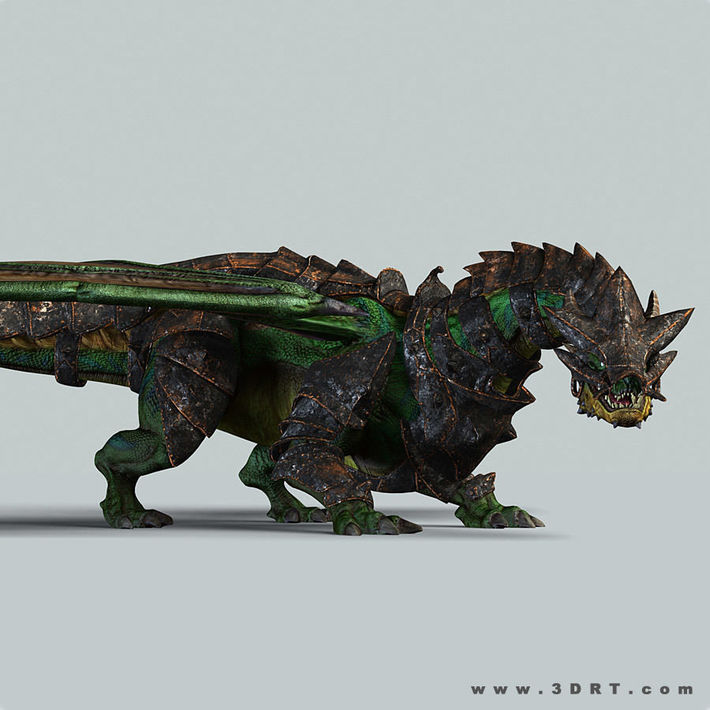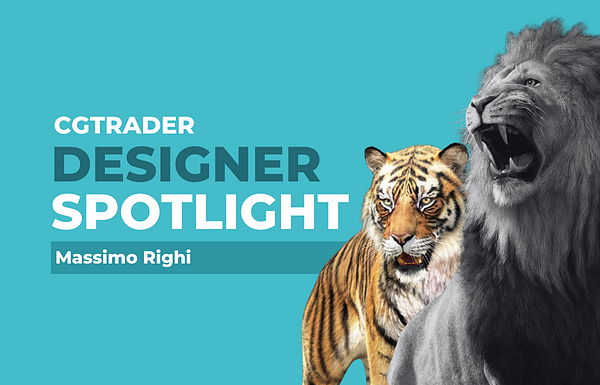We talked with three members of CGTrader community that have been our members for quite some time now. 3DRTcom is a designer who specializes in cool low-poly 3D models for video games and other real-time applications, DesignConnected focuses on high-quality photo-realistic 3D models for interior design visualizations, while NoneCG creates amazing content for movies, advertising and video production. Take a look at what they had to say to learn their stories and experiences with CGTrader, do’s and don’ts in the 3D field, recipes for success and how CGTrader contributes to all that.
Tell us a bit about yourself – how long are you in 3D business and how did you start? What are your main interests within 3D?
3DRTcom: I started when I was around 18 years old as an artist-hobbyist. Later on, began working in various gamedev companies. Game development has always been my main interest.
DesignConnected: We are a Bulgarian private company established in 2006. Our founders’ architectural background and passion for great interior and product design reflect in our company’s philosophy and have been the main force pushing our quality standards higher and higher.
Less than two-three years ago we have launched cgconnected.com where we started to offer 3d content, such as: flowers, interior decoration, electronics and other. These are soon to be published on CGTrader as we expect a lot of interest. We believe that accessories and decorative interior objects (also plants and flowers) will always attract interest. Visualization studios will never get enough of this kind of 3d assets. The opposite is with the furniture. Most customers have already built good libraries of sofas, chairs, lamps, etc., which can be used multiple times in different projects. Therefore, new purchases are being mostly based on specific requirements from the end-customers (interior designers, property developers, etc.). This is also one of the reasons why custom-modelling services will continue to predominate in this niche (we do have our Models-on-Demand service, to respond to that demand).
Another interesting project we’ve been developing is Connecter - our free 3d assets management software. Connecter helps artists to easily organize their 3d assets in a more visual and interactive way and offers some advanced functionality when placing/populating scenes in 3ds Max. In addition, there are great tools for saving and updating assets in 3ds Max.
NoneCG: NoneCG was founded in 2004 after years of working in production at several companies in different industries related to computer-generated visuals. As a founder, I had a background in both video game and publishing industries, but most recently in Film and TV. From the somewhat frustrating experiences in these production areas emerged a goal to provide top quality content that is ready for production at competitive prices.
You have had a profile on CGTrader for a while, why did you start back then?
3DRTcom: To be honest, I wasn’t looking for more ways to sell at that time but very helpful people from CGTrader inspired me to start. Made a quick research about the company, though I had already been hearing about CGTrader.
DesignConnected: As more and more people started to recognize CGTrader.com as THE place for all 3d models, we have decided that it’s already time to present our products on its community. Only a few months later it proved to be a good move for our business.
NoneCG: We've been selling 3D assets for 15 years now, even before NoneCG existed as such, and thus we have a long experience in almost all the CG 3D marketplaces. Without a doubt, CGTrader has always been the marketplace that adopted the policies and business model that we see as the most ideal for all the parts involved: the content creator, the distributor and the customer.
During all these years we always felt that most marketplaces favored a kind of chaos and unfair competition between sellers because they were profiting a lot from that lack of understanding and cooperation between content creators. We, at NoneCG, think that at CGTrader, sellers and users benefit from the exact opposite policy, and that is a much better way of thinking about the future.
How do you think CGTrader changed over that time? What are the biggest or most important improvements for you on the platform?
3DRTcom: Changes I noticed happening on CGTrader were improved tools and the website in general. As for biggest and most important improvements for me, I would say that my audience got bigger. A lot was done, but even more can be reached. For instance, the change I would like to see happening would be an improvement of the front page products’ suggestions.
DesignConnected: Over time, CGTrader tested different concepts about payments, royalties and other, to shape its platform as the leading 3d models’ marketplace. The transparent communication between sellers and buyers and the effective and stimulating rating system are key advantages. We also find the sales initiatives as a very important and successful marketing strategy.
NoneCG: Last update has been specially noticeable. Product analytics is a great addition. There is a lot more sales now due to increased marketing, and that is usually the biggest concern for content producers. But the most important thing for us is that CGtrader keeps the same principles from the start: respect for the artists and their hard work.
The CG 3D content industry is represented in two very different ways of doing business:
The old business model represented by many marketplaces that offer minor differences over the same policies: minimizing the role and presence of the real content creators, imposing strict rules and trying to strip them of certain artistic and marketing independency, and usually acting as a "human firewall" between them and the final customers. The classic unfair scheme where the middleman gets most of the profit, and the content producers doing the heavy lifting get less and less over time and their brands get dissolved and absorbed by the marketplace's own brand.
On the other hand, the new model established by CGTrader empowers the real content creators, giving us all sorts of freedom regarding our product and image, and encouraging communication with customers and fellow creators. Plus giving much higher royalties, much better support, publishing system, etc.
On top of that, it has been the fastest growing marketplace. CGtrader represents a present and a future where the content creator and the marketplace feed each other on what they do best, with trust and respect on both parts.
This is what we think is the most important "feature" that needs to be preserved above all at CGtrader.
What are the key trends related to stock 3D models, selling and usage of these you see happening now in the market?
3DRTcom: I notice the market being flooded with underpriced models. I believe, that this is actually killing our development because it results in a halted production of lots of new projects that we have.
DesignConnected: Stock 3d models’ market has a lot of niches and each one of them with its own specifics. As for the interior design niche, in which we operate, a lot has changed during the last few years. The market is flooded with furniture models (driven by the growing Architectural Visualization market), so now, more than ever, our main focus is on the quality and user experience, as well as providing market with various file formats and render engines, free content and tools, etc. Our biggest advantage has always been our direct collaborations with the furniture brands to ensure the highest standards of our content. However, there are only a few providers to make business out of production of interior models. There are more areas for individual 3d artists and small teams, which offer better liquidity and return on the hard work invested. CGTrader has some brilliant infographics that give some great insights on this.
NoneCG: We see an increased interest in real-time high quality models. Realtime engines like Unity and Unreal are so powerful and so popular now that there is a big new wave of indie studios developing all sorts of apps and games with them.
There is a lot of projection art these days, too. Lots of events with prerendered sequences involving different 3D elements.
How would you describe typical buyer of your models on CGTrader? Where are the models being used mostly?
3DRTcom: Our typical buyers are mostly game developers, as game development is our main field. Most of them want to get as many models as possible for the lowest prices and with that, get hours of free support.
DesignConnected: Our customers are mostly architects/interior designers and visualization artists. Our 3d models are used in the production of all kinds of Architectural Visualization presentations - interior projects, property developments, architectural competitions.
NoneCG: We focus on high quality realistic models, so most of our customers are studios and professionals doing TV and Film productions. Our models and scenes have been used by various types of customers: from big to small studios working in Film, TV, Videogames and Advertising (Sony, US Army, Boeing, to name a few of the top of my head) to freelancers and even hobbyists.
If you want/can reveal, what is the best-selling model of yours and, in your opinion, what are the factors of the success of that particular model?
3DRTcom: I think the model of a hare. I've noticed that this one was pretty popular: To answer why, mostly coincidence and CGTrader's search/positioning algorithms.
DesignConnected: We have many best-selling products but it’s always hard to tell what part of their success is due to the quality of our 3D models or the popularity of the particular brand or product. But it’s proved that even a very popular product won't attract many buyers if it doesn’t meet certain visual and technical standards. People tend to be very intuitive about bad quality and can’t be tricked by product descriptions or dozens of presentation renderings.
NoneCG: This is a tricky question, because there's a whole history of people in 3D marketplaces trying to figure out which models sell the best to just copy them and try to sell them at a lower price. Undercutting has been a serious problem since the start, and there hasn't been a definitive solution to it yet.
For us it's a mix of different architectural and animal models. Our approach has been trying to figure out what's really useful for the kind of customer we like, and then going for the top quality they expect. These models take months or even years to finish with all the subtle details and care for all the elements involved. It can be a huge effort on your side but good customers always appreciate quality and are ready to pay for it. And matching the quality while undercutting the price of a high quality model that takes months to make is no easy task for anybody, so you will always be better protected against undercutting.
Do you consider yourself a successful seller on CGTrader? Who do you think should and shouldn't join the platform?
3DRTcom: I don't consider our sales as very successful but appreciate all the help and improvements on CGTrader greatly. We have worked with most of the 3d online selling platforms and I must admit that CGTrader was the most fair and has the greatest potential of them all.
DesignConnected: CGTrader generates a good business for us and we’re more than happy that we’ve finally opened our shop here (the existing API and kind support helped a lot).
CGTrader is a perfect option for those ready to invest in time and in their efforts in a long-term perspective. Additionally, to start building reputation based on quality and persistence. It's also a good option to create a portfolio to attract potential custom-modelling or visualization customers.
If someone is looking for quick wins, upload-get-cash-and-forget type of deals, it's better to look somewhere else. We think that the interaction with the community and the excellent support are the main essentials for the success on CGTrader.
NoneCG: We consider our business philosophy a success, because we've been able to avoid most of the problems associated with the 3D assets industry by doing what we love the most: working with care for the details and spending the necessary time to reach our top quality without the pressure of a short deadline.
CGtrader is by far the best place for anybody to build a professional career selling 3D content:
- For starters, we get the highest royalties % for our hard work. And nobody asks you to reduce your visibility and go "exclusive".
- In CGtrader we have a Management that practices Fair Business and a Support that really cares for our brand and products. Young people developing fresh business ideas on a dynamic marketplace that is giving the market the shake it needed since more than a decade. It's really no surprise that CGtrader is, and has been for many years, the fastest growing marketplace.
- We have direct contact with our customers. Your customers are the best people to tell you how to improve your work, what they need and what they value the most (spoiler: it's quality :) )
- And last but not least, in CGtrader you will find a whole ecosystem of 3D artist like you in a healthy social environment that encourages communication and knowledge sharing.
What advice could you give to others to improve their performance?
3DRTcom: CG market requires a lot of patience, so my advice would be to be ready and expect that sometimes your efforts may not pay off as much as you could have expected.
DesignConnected: It’s a cliche but we’d only recommend other providers to focus on maximum quality and value for the customer. It also makes sense to do some research before the start of a creation of a new asset. The market doesn't need 100+ variations of the same product but rather more diversity. Repeating what others have already done and providing it with a lower price won’t be very rewarding and profitable.
NoneCG: These, we think, are the best advices for anyone in this industry:
- Only do business with people/companies you have proof you can trust. Find more extended info on this point.
- Build your own brand with your own goals. Be patient to build your own quality products, as opposed to trying to get a big library of low value models or ripping off somebody else's products.
- Never go exclusive for ANY marketplace. Wide visibility is an important step to build your own brand, don't trust any offer that asks you to renounce to part of it and become their sub-brand.
- Be original and don't settle for quick and simple models any other can make. There's going to be someone cheaper than you sooner than later.
- Find a way of loving your daily work. If you are just obsessed with earnings and fast growing, there's a high chance that you're not gonna make it in the long run. Do the models you like to do and are best suited for your taste, strength and skills, instead of just what you think will sell the most.












Comments